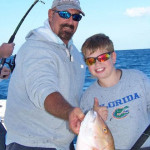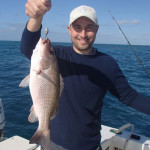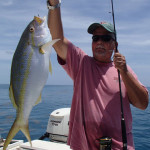Rigid flexibility. That catch phrase is the essence of how to plan your fishing trip in February’s often volatile weather patterns. The winds can go from perfectly calm one day to thirty knots the next with the passing of a cold front. Staying ready to get out on the calm days and jumping when you get the chance will allow you a lot of great fishing past the reef line this month. For the days on the wrong side of a front you need to be flexible. Staying with a plan to take folks offshore when the conditions are less than favorable is a recipe for unhappy clients.
I prefer to plan for the good weather and have a backup plan if it is not what was expected. Spending the time talking with clients gives me a feel for what they may be comfortable with. A couple of adventuresome thirty something’s might be happy to get out into six foot seas with a cross wind and drift for sailfish while another group scheduled for the same trip with a few younger children will be very appreciative of an offer to stay inshore and fish the channels for snapper and sharks.
The days that are too rough to venture out at all are rare – as long as you have a backup plan. Forecasts are less than reliable for much of the year and I have been known to err on both sides of a forecast. The joke that a forecast of ten to fifteen is just as likely to end up ten plus fifteen is closer to reality than joke. I am here to tell you that there is a world of difference on being offshore in ten knots as opposed to twenty five.
Whatever the wind gods decide to give you February holds promise of great fishing both inshore and out. Offshore offers the heart of the sailfish season where any day with a moderate breeze will offer shot after shot at sails cruising down sea feeding as they go. For these first among equals live bait is paramount. Not that it is impossible to take the occasional sail on dead bait it is just that the odds are greatly stacked in favor of the angler with the live offering. Ballyhoo is the most popular of the sailfish live baits both for effectiveness and availability. Live blue runners and goggle eyes might be more favored by the sails but acquiring them is much more specialized and labor intensive than most anglers, me included, are willing to invest.
Drifting live ballyhoo or pilchards just outside of the reef line can also give you shots at other Keys favorites such as dolphin and black fin tuna. If you are plagued by undesirable fish like king mackerel tearing up precious live bait I recommend moving out a little farther from the reef line. Depths between one hundred and fifty and two hundred fifty feet are most likely to hold fish.
Reef bottom fishing can be on fire this time of year as long as you are willing to release the otherwise legal grouper due to the closed season of January through April for all Monroe County landings. The consolation prize is that the snapper fishing is good enough to take up the slack left by the grouper closure.
As for the days that luck turns her head away from you and refuses to smile with regards to the wind velocity, there are plenty of inshore places to tuck in and enjoy the day. Channels hold sharks to snapper and there are lady fish and trout to be had in the basins. February also heralds the beginning of the tarpon migration. The channels of the backcountry are usually the first place where the silver kings are likely to pop up.
My fishing ADD is often an important part of my success inshore this time of year. I will usually start my day fishing the channels. The ones by the Harbor Key Bank are a particular favorite. They will often reward us with mangrove snapper, cero mackerel and a variety of sharks. When that action slows, drifting the deeper basins and the deeper edges of the gulf over grassy bottom with Gulp lures, new penny colored, is my favorite scented jig. They will be readily accepted by trout, acrobatic lady fish, mackerel, grouper and snapper. As you drift over the flats you can regulate the speed of your jig by throwing more ahead of the drift for a fast drift and more behind your drift for a slower one. That way you can maintain a steady retrieve and keep the jig where you want it in the water column.
By making a plan with all intentions of sticking with it but being willing to completely change it at the last minute, if need be, you are assured a great fishing trip.




